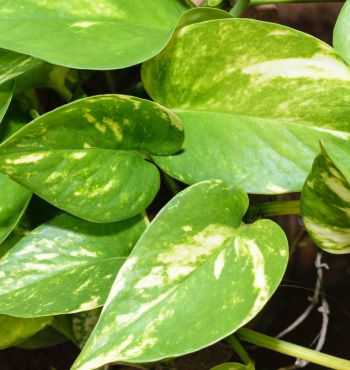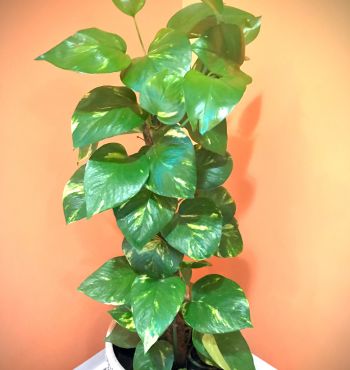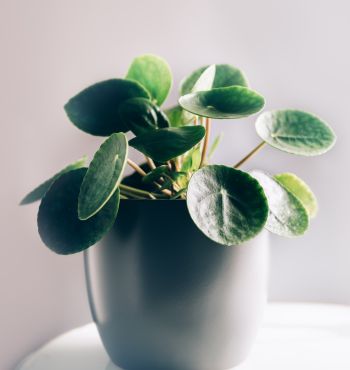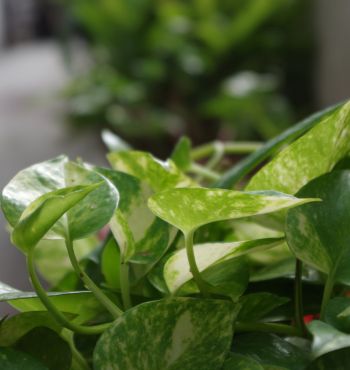Money plants are of three types: Epipremnum aureum, Crassula Ovata, and Pilea Peperomioides. Each variety has distinct characteristics and benefits.
Types of Money Plant, also known as pothos, jade plant, and Chinese money plant, are popular indoor plants for their purported ability to bring prosperity and good fortune. The Epipremnum aureum, commonly called pothos or devil’s ivy, is easy to grow and great for purifying the air.
The Crassula ovata, or jade plant, is known for its thick, glossy leaves and symbolizes good luck and fortune in many cultures. The Pilea peperomioides, or Chinese money plant, is recognizable by its round, pancake-shaped leaves and is believed to bring financial success. Each type of money plant is unique and can make a lovely addition to your indoor space.
Lucky Money Plant Varieties

Lunar Calendar Plant
The Lunar Calendar Money Plant, also known as the Pachira Aquatica, is renowned for its auspicious and prosperous traits in Feng Shui. This varietal of the money plant is believed to bring good luck and fortune, making it a popular choice for home and office decoration.
Tricolor Money Plant
The Tricolor Money Plant is a captivating variant with three-colored leaves that symbolize financial growth, health, and good luck. Believed to bring wealth and prosperity according to Feng Shui principles, it is an attractive and meaningful addition to any indoor space.
Benefits Of Money Plants
Money plants, also known as Pothos or Devil’s Ivy, are popular houseplants that offer numerous benefits. From air purification to enhancing positive energy, these plants bring positivity and tranquility to any space. Let’s explore the key advantages of having money plants in your home.
Air Purification
Money plants are excellent natural air purifiers, as they have the ability to remove toxins such as formaldehyde and benzene from the air. This makes them ideal for improving indoor air quality, promoting a healthier living environment.
Feng Shui And Vastu Benefits
In Feng Shui, the money plant is believed to bring prosperity, good luck, and financial abundance. It is often placed in the wealth or prosperity corner of a home to attract positive energy. Similarly, in Vastu Shastra, money plants are associated with wealth and positivity, making them a popular choice for home decor.
Caring For Money Plants

The key to keeping your money plant thriving lies in understanding its care requirements. By providing the right amount of light, temperature, water, and fertilization, you can ensure the well-being of your money plant. In this article, we will discuss the specific care needs of money plants, focusing on light and temperature, watering, and fertilizing.
Light And Temperature
Money plants thrive in bright, indirect light. Place your money plant near a window with filtered sunlight or in a well-lit area of your home. Avoid exposing the plant to direct sunlight as it can scorch the leaves. If you notice your money plant leaning towards the light source, rotate it every few weeks to ensure even growth.
When it comes to temperature, money plants prefer a mild climate. They can tolerate a wide range of temperatures, but the ideal range is between 65-75°F (18-24°C). Avoid exposing the plant to extreme temperatures or drafts, as this can cause stress and hinder its growth. If your home gets too cold during winter, consider moving your money plant to a slightly warmer spot.
Watering And Fertilizing
Proper watering is essential for the health of your money plant. Water your plant thoroughly when the top inch of soil feels dry to the touch. Pour water slowly and evenly over the soil until it drains out of the bottom of the pot. Ensure there are drainage holes to prevent waterlogging, as too much moisture can lead to root rot.
During the growing season, from spring to summer, money plants require more frequent watering. In contrast, reduce the watering frequency during the dormant period in winter. However, always monitor the moisture level of the soil and adjust your watering accordingly to prevent underwatering or overwatering.
In terms of fertilization, money plants are low-maintenance. You can feed your plant with a balanced liquid fertilizer once a month during the growing season. Follow the instructions on the fertilizer package for the correct dilution ratio. Avoid over-fertilization as it can burn the roots and damage the plant.
Propagating Money Plants
Money plants, also known as Devil’s Ivy, are popular houseplants due to their attractive foliage and easy maintenance. One of the great things about money plants is that they can be easily propagated, allowing you to create new plants from an existing one. There are three main methods for propagating money plants: stem cutting, water propagation, and layering. In this article, we will focus on the process of propagating money plants using stem cuttings and water propagation.
Stem Cutting
Stem cutting is one of the most common methods used to propagate money plants. Here is a step-by-step guide on how to do it:
- First, select a healthy stem from the money plant that is long and has at least a few leaves.
- Using a clean, sharp knife or scissors, make a clean cut just below a leaf node. A leaf node is where a leaf is attached to the stem.
- Remove the lower leaves from the cutting, leaving only a few leaves at the top. This will help the cutting focus its energy on growing roots instead of supporting leaves.
- Fill a small container with well-draining soil or a mixture of soil and perlite.
- Make a small hole in the soil with your finger and insert the cutting into the hole. Gently press the soil around the cutting to ensure good contact.
- Place the container in a warm and bright location, but avoid direct sunlight.
- Water the cutting lightly, making sure not to overwater it. The soil should be slightly moist, but not waterlogged.
- After a few weeks, you should start to see new root growth. Once the roots are well-established, you can transplant the new plant into a larger pot if desired.
Water Propagation
Water propagation is another popular method for propagating money plants. Here’s how you can do it:
- Take a healthy cutting from the money plant, making sure it has a few leaves and a node.
- Fill a glass or jar with clean water, making sure that at least half of the cutting is submerged.
- Place the container in a bright location, but away from direct sunlight.
- Change the water every few days to prevent stagnation and promote root growth.
- Within a few weeks, you should start to see roots forming from the nodes of the cutting. Once the roots are well-developed, you can transfer the cutting into a pot with well-draining soil.
Propagating money plants through stem cuttings and water propagation is a rewarding experience that allows you to expand your collection of these beautiful houseplants. Whether you choose to use stem cuttings or water propagation, make sure to provide the right conditions and care for the new plant to ensure its successful growth.
Common Issues And Troubleshooting

Maintaining a money plant can be a rewarding experience, but like any other plant, it may encounter some common issues and require troubleshooting. By understanding the potential problems that can arise and how to address them, you can ensure that your money plant continues to thrive. In this article, we’ll explore three common issues you may encounter with your money plant, including yellowing leaves and pest infestations, and provide you with practical solutions to overcome them.
Yellowing Leaves
One of the most common issues faced by money plant owners is the yellowing of leaves. Yellow leaves can be a sign of various problems, including overwatering, underwatering, or nutrient deficiency. Additionally, exposure to direct sunlight or extreme temperatures can cause leaf yellowing.
To troubleshoot yellowing leaves, start by examining the watering routine. Ensure that you are watering the money plant appropriately, allowing the topsoil to dry out slightly between watering sessions. Overwatering can lead to root rot and yellowing leaves, so it’s essential to strike the right balance.
| Cause | Solution |
| Overwatering | Adjust watering frequency and allow the topsoil to dry out between watering sessions. |
| Underwatering | Increase watering frequency while ensuring the plant has proper drainage. |
| Nutrient deficiency | Feed the money plant with a balanced liquid fertilizer according to the instructions. |
| Exposure to direct sunlight or extreme temperatures | Move the plant to a location with indirect sunlight and avoid extreme temperature conditions. |
Pest Infestations
Pest infestations can also pose a significant challenge for money plant owners. Common pests that may affect your money plant include spider mites, aphids, and mealybugs. These pests can cause leaf discoloration, wilting, and stunted growth if left untreated.
To deal with pest infestations, it’s crucial to identify the type of pest affecting your money plant. Once identified, you can choose the appropriate treatment method. For example, using an insecticidal soap or neem oil solution can help control spider mites, while wiping the leaves with a mixture of water and dish soap can eliminate aphids and mealybugs.
Steps to Address Pest Infestations:
- Identify the pest species affecting your money plant.
- Research suitable treatment options for the identified pest.
- Prepare and apply the recommended treatment, following the instructions carefully.
- Monitor the plant closely to ensure the pests are eliminated and prevent further infestations.
By being proactive in addressing these common issues and troubleshooting them promptly, you can ensure the health and vitality of your money plant. Remember to regularly inspect your plant, adjust watering routines if necessary, and take the appropriate measures to combat pest infestations. With proper care and attention, your money plant will flourish, bringing beauty and abundance into your living space.
Myths And Folklore

The money plant, scientifically known as Epipremnum aureum, is not just a beloved houseplant but also a symbol of good luck and abundance. Throughout history, it has been associated with various myths and folklore. Let’s explore some of the fascinating beliefs and superstitions surrounding this beautiful plant.
Wealth And Prosperity Beliefs
Many cultures believe that having a money plant in your home brings wealth and prosperity. According to Chinese folklore, it is believed that the money plant attracts fortune and positive energy. The five leaves of the money plant symbolize the five elements, namely, wood, water, fire, earth, and metal, which are essential for a harmonious life.
In Feng Shui, a practice originating from ancient China, the money plant is considered an excellent choice to attract abundance and success. It is believed to purify the air and improve the flow of chi, the life force energy, promoting prosperity and financial growth. Placing a money plant near your front entrance or in the southeast corner of your home or office is said to maximize its positive effects.
Superstitions And Warnings
Although the money plant is generally associated with positive energy, some superstitions and warnings are also associated with it. In certain cultures, it is believed that if the leaves of the money plant start to wither or turn yellow, it signifies impending financial loss or bad luck. To avoid this, it is essential to care for the plant properly by providing adequate sunlight, regular watering, and occasional fertilization.
Another superstition warns against keeping a money plant in the bedroom. It is believed that the energy emitted by the plant at night may disrupt sleep patterns and cause restlessness. To avoid this, it is advisable to keep the money plant in other areas of the house, such as the living room or study.
Additionally, some cultures believe that receiving a money plant as a gift is a sign of good luck, while others believe it should be purchased for self-use to maximize its positive effects. It is important to remember that these beliefs and superstitions may vary across different cultures and individuals.

FAQ On Types Of Money Plant
What Are The Different Types Of Money Plants?
There are several types of money plants, including Devil’s Ivy, Silver Dollar, Jade, and Golden Pothos.
How Do I Care For A Money Plant?
To care for a money plant, place it in a well-lit area, water it regularly but avoid over-watering, and occasionally wipe its leaves to keep them clean.
Can Money Plants Survive In Low Light Conditions?
Yes, money plants can survive in low light conditions, but they may not grow as vigorously. It’s best to provide them with bright, indirect light for optimal growth.
How Often Should I Water My Money Plant?
Water your money plant when the top inch of soil feels dry to the touch. Avoid over-watering, as it can lead to root rot.
Can I Grow A Money Plant In Water?
Yes, money plants can be grown in water. Simply place a healthy cutting in a container with water and watch it develop roots before transferring it to soil.
Conclusion
To sum up, the money plant is a fascinating addition to any home or garden. With its variety of types, including the Jade, Golden Pothos, and Chinese evergreen, there is a money plant to suit every style and space. Whether you’re looking to bring good luck, improve air quality, or simply add some greenery to your surroundings, the money plant is a perfect choice.






